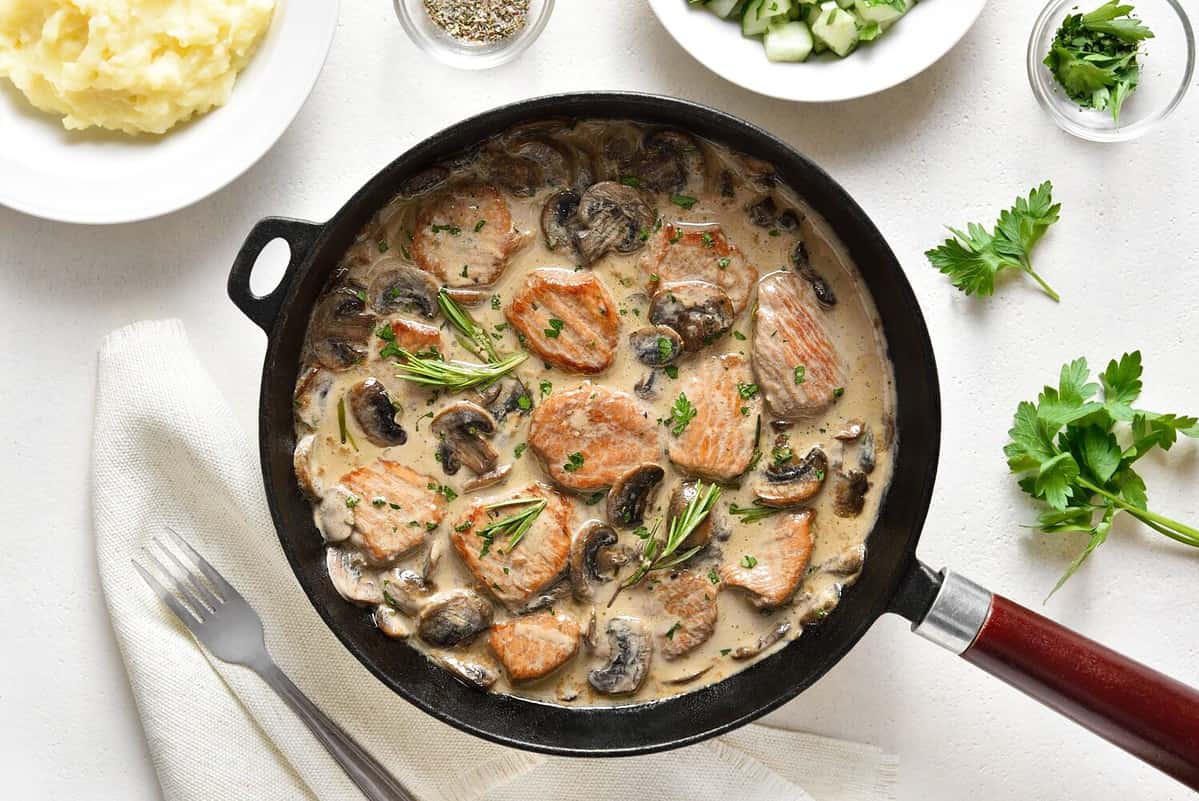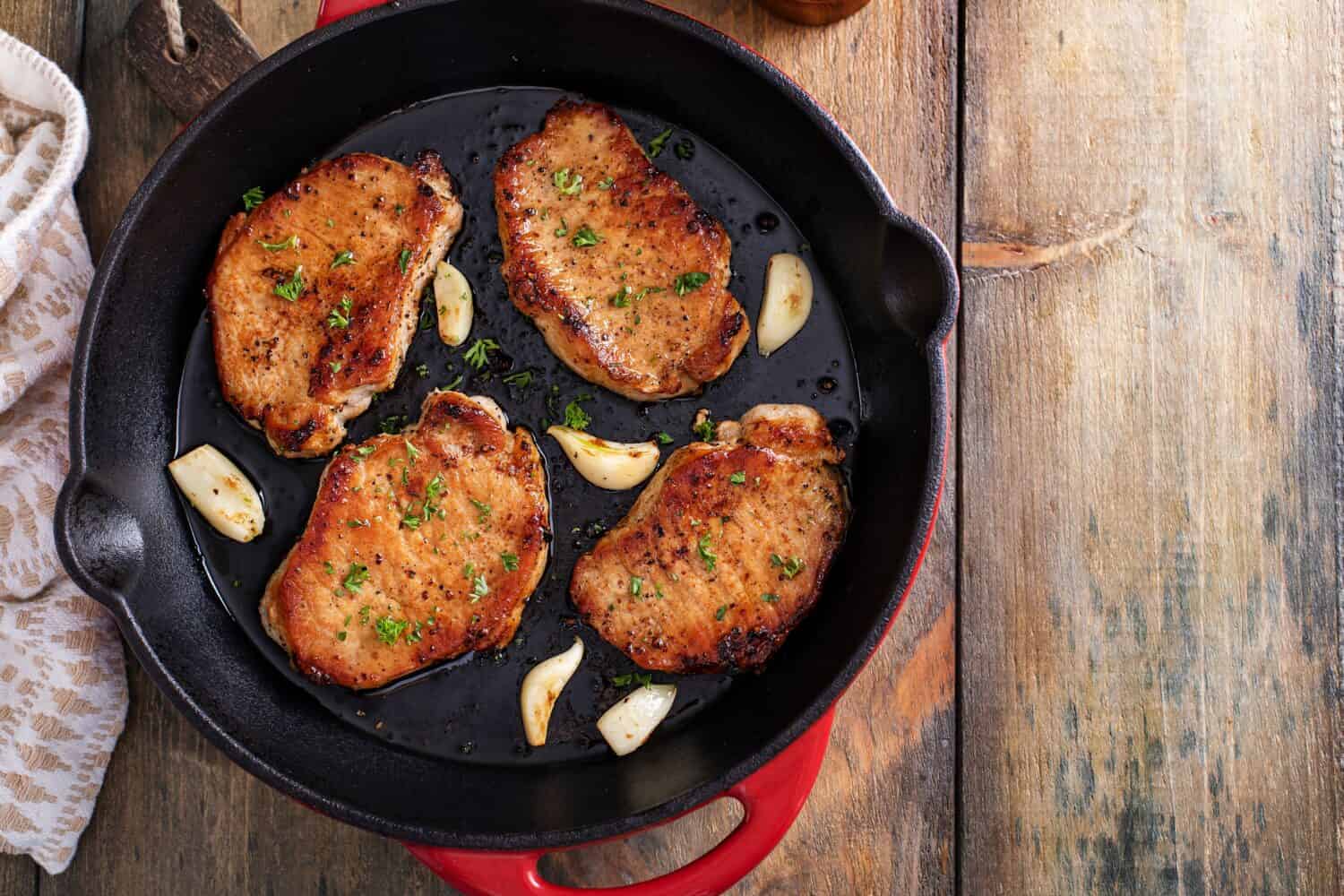Most chefs and home cooks will have a few cast iron pans in their arsenal, and they certainly serve their purpose. However, not all pans are created equal, and while cast iron does have its perks, it’s far from perfect, and there are many negatives to consider. Today, we’ll tell you about 12 reasons to avoid cooking with cast iron. We’ll also tell you about a few alternatives that you can try instead.
What is Cast Iron?
Cast iron pans have been around for many years, and that’s because the material is very durable. These pans are not 100% iron. To make cast iron, a material known as iron ore is heated in a furnace. It’s there that it becomes molten. That hot molten metal is then cast into the shape of an ingot. That ingot is then melted down again until it becomes the final shape of the pan.
While the words “cast iron” are used as a general term, not all are created equal. There are actually four different subtypes of cast iron alloy:
- Ductile Cast Iron – It has nodules of graphite that make it ductile and strong.
- Gray Cast Iron – It includes flakes of graphite that improve its machinability.
- White Cast Iron – This iron contains iron carbides that make it good for wear and tear.
- Malleable Cast Iron – This iron has been heat treated, and it’s similar to ductile cast iron.
In addition to cookware, cast iron is used for many other items, including chains, machinery, mining equipment, gears, and decorative architectural pieces, among others. Cast iron cookware can be found in many variations, including frying pans, dutch ovens, waffle irons, woks, and more.
There’s also an option to purchase enameled cast iron. That’s when the iron pan has an enamel glaze applied to the surface. It has a reduced chance of rusting, and it allows for more thorough cleaning.
Why You Should Avoid Cooking With Cast Iron
At this point, you may be thinking that cast iron cookware is perfectly fine. The description above may even make you want to buy a cast iron pan. However, before you open your wallet, there are some downsides that you’ll want to consider.
1. You Must Season the Pan
Perhaps the most significant con of cast iron cookware is that the pan must be seasoned before cooking or else the pan could quickly begin rusting over time. The good news is that if you season it regularly, your pan can last for decades. However, it’s still a task that must be done.
This issue is well known, and now many companies are selling cast iron cookware that is pre-seasoned, meaning you can start to use it right out of the box. However, acidic ingredients and detergents can break down that line of defense over time, so you must also season it yourself periodically. Even if you avoid those acidic foods, you’ll still need to season the cast iron at least twice per year.
If you do decide to buy a cast iron pan, you can season it with the following steps:
- Scrub your pan in warm water and use a drop of dish soap.
- Thoroughly rinse the soap from the pan.
- Completely dry the pan with a lint-free cloth.
- Select a high smoke point oil like coconut, vegetable, or avocado oil. Use a tablespoon and spread it evenly over the pan.
- Put aluminum foil on the bottom rack of the oven.
- Put the pan upside down on the top rack and bake for one hour at 450-500 degrees.
- Turn the oven off and remove the pan.
- Let it cool off, and use when ready.
Do this process with a pre-seasoned pan and you’ll be good for about six months.
2. Even If You Season the Pan, It Will Rust
Even with regular seasoning, if you don’t properly maintain cast iron, it will rust. Letting water sit in your pots and pans is a surefire way to see that happen. On a good note, it’s far from impossible to remove that rust. Simply use a steel wool pad and then hand wash and dry the pan. Then, re-season it again.
3. It’s Heavy
If you’re going to use cast iron on a regular basis, then you’ll need a few muscles. Some cast iron pans can weigh upwards of twelve pounds, and that’s before you put in the food. The pans have thick walls and a thick bottom, which makes them hard to move. It’s not made for flipping pancakes. You could instead use the same size pan that’s made out of stainless steel, and it will max out at less than five pounds.
4. It Has A Rough Bottom That Can Scratch Glass
Cast iron has a unique look. It’s classic and rustic, and it looks great in kitchens. However, that’s also part of its downfall. The bottom of cast iron pans are very rough so you need to be careful when using it on glass tables and cooktops. You also need to be sure to pick the pan straight up and avoid dragging it, or it will scratch the glass.
5. It’s Very Reactive
Like other types of pans, cast iron is very reactive, so acidic foods, like wine, vinegar, and citrus fruit, can often get past the seasoning and react with the cast iron. If that happens, it can alter the color or taste of the food that’s being cooked. If you want to make acidic or tomato-based recipes, you’re better off using a different type of pan.
6. Food Often Sticks
This is yet another reason why seasoning the pan is so important. Failure to season or oil the dish can cause food to stick to the cast iron surface. Even if it is properly seasoned, there’s still a chance that the food will stick because it doesn’t have the same degree of food release as many non-stick pans.
7. Hard to Clean
Cleaning a cast iron pan is quite a process. It is not dishwasher-friendly. Also, soaking it in water can strip the seasoning and cause the rust we discussed earlier. The only way to properly clean this material is to wash and dry it by hand. Once you dry it, add a light layer of oil to preserve its quality. At most, use a chainmail scrubber to strip away tough grime. You can use a small amount of dish soap, but be careful because it can ruin the seasoning.
8. You Can’t Use It for Boiling
Although you could technically use a cast iron pan to boil liquids, it’s highly discouraged because doing so will strip away the seasoning. If you’re preparing a recipe that requires boiling, do it in a different pan and then go from there.
9. It’s Slow to Heat
This is not the type of material you should look at if you’re trying to prepare a fast meal. Iron, by nature, is a poor heat conductor, and when you combine that with thick construction, you’ll find that the cookware takes a long time to heat. Now, once it’s quite hot, it's hot, but it takes a while. In some cases, it can take close to four minutes to boil to cups of water, which is twice the amount of time it takes in an aluminum or stainless steel pan.
10. The Handles Get Very Hot
Again, once the cast iron pan gets hot, it’s very hot. That’s an issue when it comes to the handles because a cast iron pan is all one piece. So when the surface is scalding, so are the handles, so you must use pot holders or something stronger. For the best chance of success, invest in oven gloves that can handle 600 degrees Fahrenheit or hotter.
11. Uneven Heating
While cast iron will eventually get very hot, the heat is not always even. Cast iron will often have hot spots so you need to be careful when preparing food to ensure that everything is really cooked to your liking. Other materials, like aluminum and stainless steel, have more even heating.
12. There Are Many Foods You Can’t Cook In Cast Iron
Perhaps the biggest drawback of cast iron is that you’re limited in the number of items you can cook. There are various foods that you should never cook in a cast iron pan, including:
- Tomato Sauce – This is a classic acid food that will damage the seasoning on your pan, and it will taste metallic when you eat it.
- Omelets – Eggs and omelets can be tough in cast iron because they tend to stick to the surface. When you finally get the eggs off and try to clean the pan, you can strip some of the seasoning.
- Fish Filets – They’ll also get stuck to the cast iron.
- Garlic and Peppers – These and other smelly things can get stuck into the porous nature of the pan. Then, foods you cook afterward can also have that smell.
Benefits of Cast Iron

Although cast iron does have its downsides, there are also a few perks.
©Tatiana Volgutova/Shutterstock.com
While we’re not recommending cast iron today, it’s fair to point out that there are some benefits to this type of pan. One of them is that you can use it to cook anywhere, from a stovetop to an open campfire. It’s also very tough, almost indestructible. If you preserve the seasoning, it also has a naturally nonstick finish, which is a great benefit. It’s also rather straightforward to use. Finally, when used properly, its heat retention typically makes the food cooked in it taste a bit better.
Alternatives to Cast Iron
If you like the idea of cast iron, but you’re turned off by the downsides we mentioned above, then you’re in luck. There are several alternatives to consider when you decide to avoid cooking with cast iron:
- Fry Pan – If you love your eggs, you can cook them in a fry pan. The pan can also be used to saute vegetables and cook a variety of foods. It’s also more lightweight than cast iron.
- Grill Pan – Use it to cook your favorite vegetables and meats, and you can char and sizzle them to perfection. This type of pan is also made out of cast iron, so it can withstand high temperatures.
- Stainless Steel – This and other multi-ply pans can cook a variety of foods, and they distribute heat evenly, unlike cast iron.
- Non-Stick – Pans with traditional non-stick coating and ceramic non-stick coating are a great addition to a kitchen, and your food won’t get stuck.
- Carbon Steel – This is a similar type of pan that's much more lightweight than cast iron, so it’s easier to move and use. Carbon steel also cools down faster, so it’s less of a hazard.
Conclusion
As you can see, there are several reasons to avoid cooking with cast iron, especially if you don’t have a specific need for the cookware. Of course, this type of pan may be just what you need, but you must weigh the pros and cons. Do your research and find the pan that can improve your kitchen.
The image featured at the top of this post is ©Elena Veselova/Shutterstock.com
